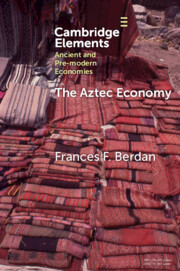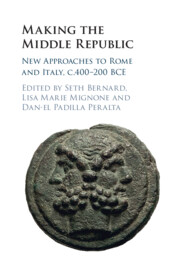Refine search
Actions for selected content:
23990 results in Ancient history
Bibliography
-
- Book:
- Making the Middle Republic
- Published online:
- 20 April 2023
- Print publication:
- 27 April 2023, pp 270-330
-
- Chapter
- Export citation
Conclusion
-
- Book:
- Making the Middle Republic
- Published online:
- 20 April 2023
- Print publication:
- 27 April 2023, pp 251-269
-
- Chapter
- Export citation
5 - Building up Slaveries in Ancient Italy and the Central Sudan
- from Part I - Historical Sources
-
-
- Book:
- Making the Middle Republic
- Published online:
- 20 April 2023
- Print publication:
- 27 April 2023, pp 80-100
-
- Chapter
- Export citation
3 - The Long Shadow of Tributum in the Long Fourth Century
- from Part I - Historical Sources
-
-
- Book:
- Making the Middle Republic
- Published online:
- 20 April 2023
- Print publication:
- 27 April 2023, pp 38-63
-
- Chapter
- Export citation
Acknowledgments
-
- Book:
- Making the Middle Republic
- Published online:
- 20 April 2023
- Print publication:
- 27 April 2023, pp xvi-xvii
-
- Chapter
- Export citation
Part III - Architecture and Art
-
- Book:
- Making the Middle Republic
- Published online:
- 20 April 2023
- Print publication:
- 27 April 2023, pp 191-250
-
- Chapter
- Export citation

The Aztec Economy
-
- Published online:
- 25 April 2023
- Print publication:
- 18 May 2023
-
- Element
- Export citation

Making the Middle Republic
- New Approaches to Rome and Italy, c.400-200 BCE
-
- Published online:
- 20 April 2023
- Print publication:
- 27 April 2023
Index
-
- Book:
- Monastic Economies in Late Antique Egypt and Palestine
- Published online:
- 14 April 2023
- Print publication:
- 20 April 2023, pp 390-396
-
- Chapter
- Export citation
Appendix: Transliteration and Translation of P.Ness. III 79
- from 10 - Distinguishing Offerings from Blessings in Early Byzantine Monasticism: The Significance of P.Ness. III 79 (ca. 600 AD)
-
- Book:
- Monastic Economies in Late Antique Egypt and Palestine
- Published online:
- 14 April 2023
- Print publication:
- 20 April 2023, pp 291-297
-
- Chapter
- Export citation
I. - The Monastic Estate
-
- Book:
- Monastic Economies in Late Antique Egypt and Palestine
- Published online:
- 14 April 2023
- Print publication:
- 20 April 2023, pp 39-126
-
- Chapter
- Export citation
Glossary
-
- Book:
- Monastic Economies in Late Antique Egypt and Palestine
- Published online:
- 14 April 2023
- Print publication:
- 20 April 2023, pp 387-389
-
- Chapter
- Export citation
Contents
-
- Book:
- Monastic Economies in Late Antique Egypt and Palestine
- Published online:
- 14 April 2023
- Print publication:
- 20 April 2023, pp v-vi
-
- Chapter
- Export citation
3 - Monastic Estates in Transition from Byzantine to Islamic Egypt: Evidence from Aphrodito
- from I. - The Monastic Estate
-
-
- Book:
- Monastic Economies in Late Antique Egypt and Palestine
- Published online:
- 14 April 2023
- Print publication:
- 20 April 2023, pp 76-98
-
- Chapter
- Export citation
Tables
-
- Book:
- Monastic Economies in Late Antique Egypt and Palestine
- Published online:
- 14 April 2023
- Print publication:
- 20 April 2023, pp x-x
-
- Chapter
- Export citation
III. - Monastic Encounters: Travel, Pilgrimage, and Donations
-
- Book:
- Monastic Economies in Late Antique Egypt and Palestine
- Published online:
- 14 April 2023
- Print publication:
- 20 April 2023, pp 269-386
-
- Chapter
- Export citation
4 - The Naqlun Fathers and Their Business Affairs: Private Assets and Activities of the Monks in a Semi-Anchoritic Community in the Late Antique Fayum
- from I. - The Monastic Estate
-
-
- Book:
- Monastic Economies in Late Antique Egypt and Palestine
- Published online:
- 14 April 2023
- Print publication:
- 20 April 2023, pp 99-126
-
- Chapter
- Export citation
8 - It’s a Dung Job: Exploring Fuel Disc Production in Egyptian Monasteries
- from II. - Production and Consumption of Food and Material Goods
-
-
- Book:
- Monastic Economies in Late Antique Egypt and Palestine
- Published online:
- 14 April 2023
- Print publication:
- 20 April 2023, pp 212-232
-
- Chapter
- Export citation
Preface
-
- Book:
- Monastic Economies in Late Antique Egypt and Palestine
- Published online:
- 14 April 2023
- Print publication:
- 20 April 2023, pp xv-xvi
-
- Chapter
- Export citation
13 - Travel in the Texts: Monastic Journeys in Late Antique Egypt
- from III. - Monastic Encounters: Travel, Pilgrimage, and Donations
-
-
- Book:
- Monastic Economies in Late Antique Egypt and Palestine
- Published online:
- 14 April 2023
- Print publication:
- 20 April 2023, pp 359-386
-
- Chapter
- Export citation
